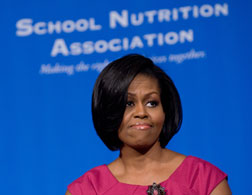Fat Kids
Get ready for a new front in the war on obesity.
For years, we've heard that Americans are getting fatter. Two-thirds of adults are now classified as either overweight or obese, and we don't know how to reduce that number. Standard "treatments"—nutritional advice, exhortations to visit the gym, products from a $60 billion weight-loss industry —don't do much good over the long term, and more ambitious plans, like soda taxes and menu-labeling laws, might not work, either.
Faced with these disheartening facts, health officials have realized it's time for a new strategy. In an effort to win the war on obesity—the spoils of which include an estimated tens or hundreds of thousands of lives per year, and billions of dollars in health care savings—they've shifted their target. Leave the adults alone; aim for the children.
In the past few weeks, fat kids have become something of a public health obsession. In February, the White House established a Task Force on Childhood Obesity and appointed Michelle Obama to lead a massive campaign, complete with fat-focused national media tour, to address the crisis. Meanwhile, new studies of child obesity are coming out on what seems like a weekly basis. Last week, the journal Health Affairs published an entire issue devoted to the topic.
A war on childhood obesity—as opposed to a campaign against fatness everywhere—has some clear advantages. It may be easier to stop a little kid from putting on weight than it is to treat an adult who's already obese, and targeting children allows for more aggressive tactics. When it comes to grown-ups, we like to think that body size is a matter of personal responsibility—that we make our own decisions about diet and exercise and face the consequences. Since we don't expect kids to make their own decisions, we're free to indulge in all sorts of nanny-state shenanigans, like mandatory gym classes and bans on cafeteria vending machines.
Michelle Obama has pledged to improve the quality of school lunches, educate parents about healthy diets, and improve access to grocery stores in poor and rural areas. But first she has to reframe the obesity epidemic in terms of America's children. At every campaign stop, the first lady repeats the same facts and figures: Childhood obesity rates have tripled over the last three decades; nearly one in three children is now overweight or obese; and the youngest generation is on track, for the first time in the nation's history, to have a shorter lifespan than their parents.
As the war on child obesity escalates, we can expect to hear these statements repeated over and over again, spreading from one politician to another, through opinion columns and television newscasts. Before that happens, let's take a quick look at what the campaign rhetoric really means.
(Click the following sentences for more details.)
Become a fan of Slate on Facebook. Follow us on Twitter.


